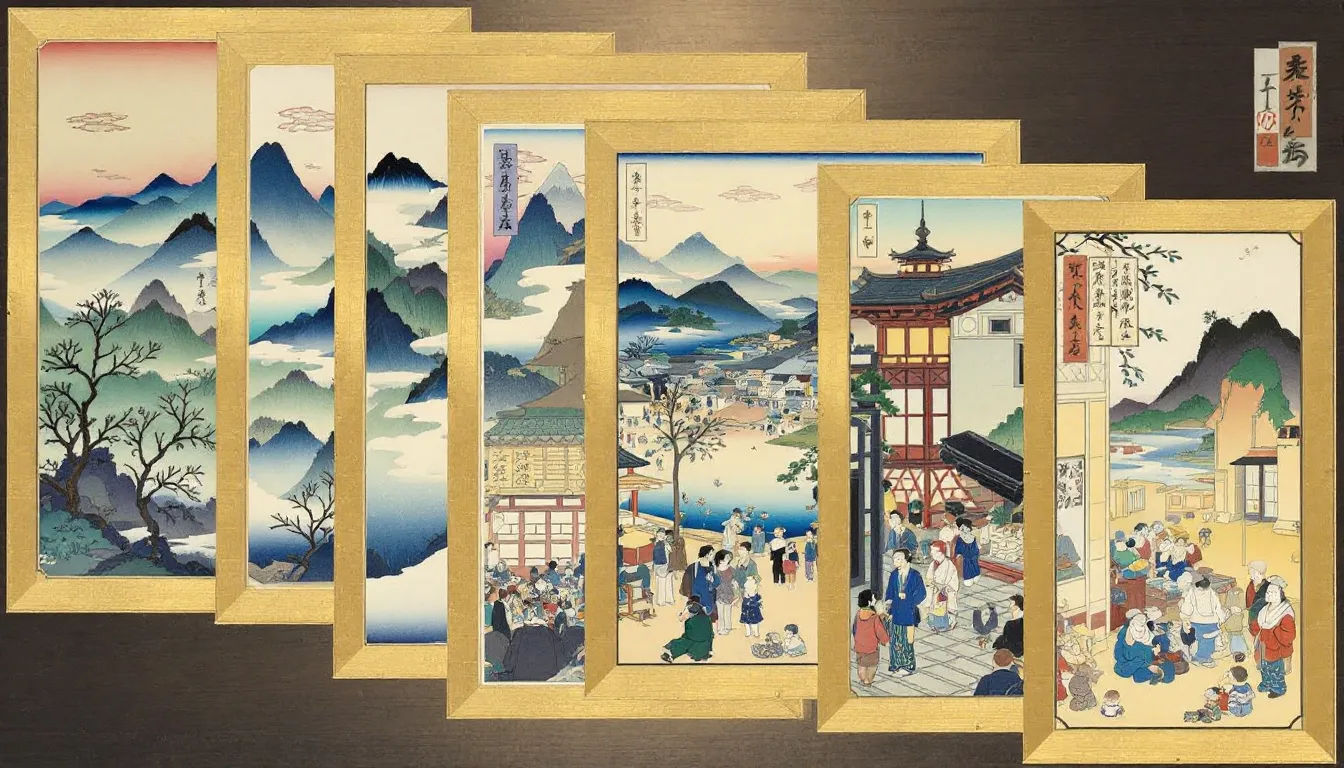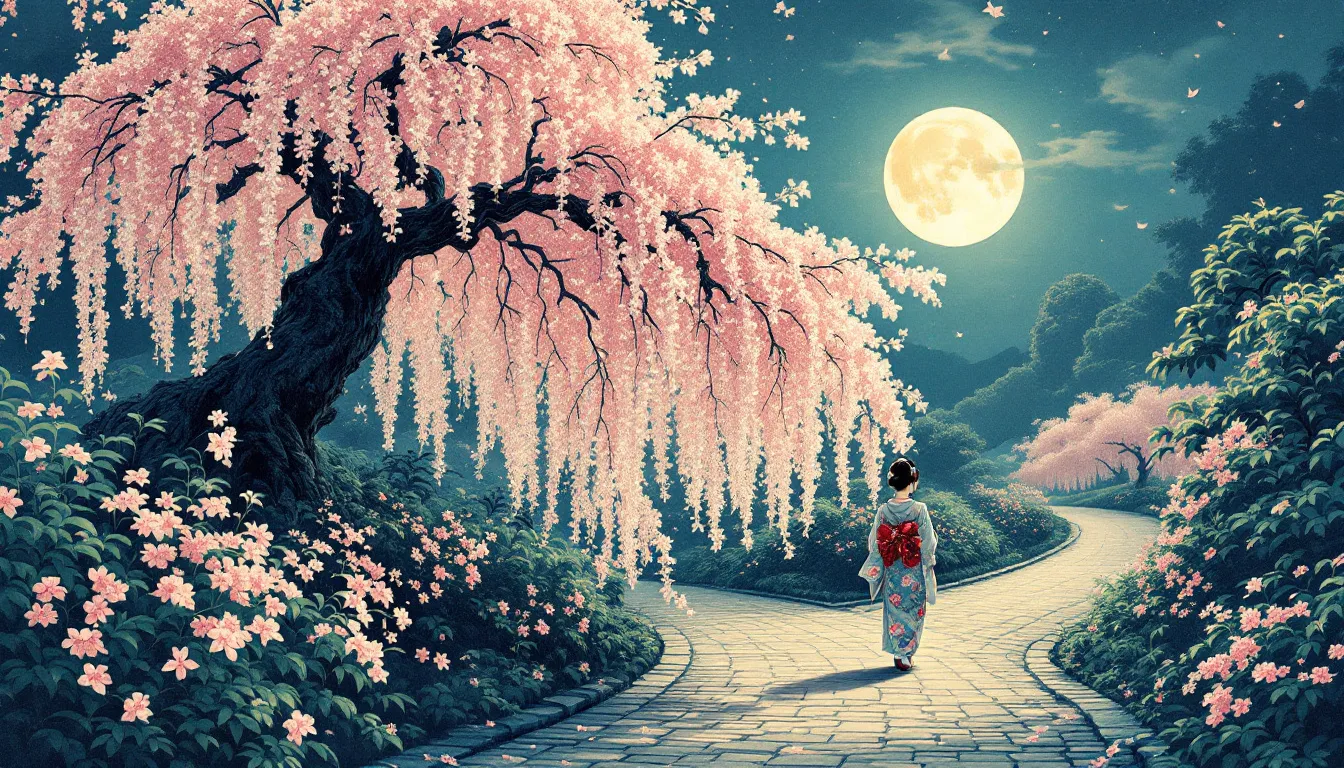Japanese art woodblock prints, starting from the 7th century, have profoundly shaped the country’s cultural identity. This article explores their history, major styles, techniques, prominent artists, and their influence on modern art.
Key Takeaways
-
Japanese woodblock printing originated in the 7th century, initially used for reproducing spiritual texts before evolving into a celebrated art form, particularly during the Edo period with ukiyo-e prints.
-
Ukiyo-e, meaning ‘pictures of the floating world,’ portrayed vibrant urban life and natural beauty, becoming accessible to the merchant class through mass production by a collaborative effort of artists and craftsmen.
-
Prominent artists like Hokusai and Hiroshige contributed significantly to the evolution of Japanese woodblock prints through innovative use of color and composition, paving the way for modern interpretations and the shin hanga movement.
Origins of Japanese Woodblock Printing
The fascinating journey of Japanese woodblock prints began in the early 7th century, when the technique was introduced from the Asian continent. Initially, this method was not used for artistic purposes but for something far more spiritual and practical. Buddhist temples in Japan embraced woodblock printing primarily to reproduce sacred texts and foreign literature. These early prints played a crucial role in disseminating Buddhist teachings and ensuring the preservation of religious knowledge.
One of the earliest significant applications of woodblock printing was commissioned by Empress Shōtoku, who ordered the production of small charms printed with Buddhist texts, intended to protect her realm. This practice marked the beginning of a long tradition where woodblock printing would evolve from a religious tool to a celebrated form of artistic expression.
As we move forward in time, we see this technique blossoming into the intricate and culturally rich art of imagination; additionally, it is known today to add.
Ukiyo-E: The Floating World
The emergence of ukiyo-e during the Edo period marked a significant evolution in Japanese woodblock printing, set apart by its unique style in the evening.
Translating to ‘pictures of the floating world,’ ukiyo-e depicted scenes from urban pleasure culture, capturing the vibrant beauties and transient nature of life in Edo (modern-day Tokyo) under the moon, serving as a representation of that era.
This genre showcased a wide array of themes, including:
-
Beautiful landscapes
-
Portraits of women
-
Everyday urban scenes
Ukiyo-e prints were produced in hundreds of large quantities and were relatively inexpensive, making them accessible to the burgeoning merchant class. New prints were particularly popular among this demographic.
The production of ukiyo-e was a collaborative effort involving the ‘ukiyo-e quartet’:
-
the publisher
-
the artist
-
the block cutter
-
the printer
This teamwork ensured the high quality and consistency of the prints. Iconic works from this period, such as Hokusai’s ‘Great Wave off the Coast of Kanagawa’, continue to resonate as cultural symbols of Japan.
Artists like Utamaro shifted the focus of the bijin-ga genre from idealized beauty to more personal and relatable depictions of women, emphasizing their individual personalities and moods. This shift not only broadened the appeal of ukiyo-e but also highlighted the evolving perspectives within Japanese society.
The ukiyo-e prints truly encapsulate the essence of the ‘floating world,’ offering a window into the dynamic and imaginative spirit of Edo-period Japan.
Techniques and Tools of Woodblock Printing
The art of woodblock printing is a meticulous process that requires precision and skill. One of the essential elements is the use of kento marks, which are precise registration marks carved into the woodblock print to ensure accurate alignment of the paper during printing. This technique is crucial for achieving the multi-colored prints that became popular in later periods.
The choice of materials is equally important. Traditionally, washi paper, made from the bark of the mulberry tree, is favored for its absorbency and texture. This paper, combined with various carving tools, allows artists to create intricate designs. Tools like ‘futo bori’ chisels are used for carving large areas, while ‘sumi bori’ chisels are employed for fine details, making it a perfect gift for those who appreciate craftsmanship.
The printing process itself involves layering colors, with each color requiring a separate woodblock and careful registration. Printing is often done using a baren, a hand-held tool that applies pressure evenly across the surface of the paper. This ensures that the ink is transferred smoothly, creating a consistent and vibrant image.
The combination of these techniques and tools has allowed artists to produce all the prints of the most detailed and colorful creative prints in art history.
Evolution of Color in Japanese Prints


The evolution of color in Japanese woodblock prints is a story of innovation and artistic ingenuity. By the mid-18th century, artists began incorporating multiple colors, layering them to achieve more dynamic images. This development marked a significant milestone, enabling the creation of full-color prints around 1765.
Artists during the Edo period began to use multiple woodblocks for each color, which added complexity and richness to their work. Hokusai and Hiroshige were instrumental in enhancing the use of color in prints. They introduced sophisticated gradients and a broader palette, allowing for more nuanced and expressive artworks.
Hiroshige’s focus on capturing the fleeting beauty of nature made his work a significant influence in both Japanese art and Western Impressionism. The evolution of color in Japanese prints not only enriched the visual experience but also expanded the artistic possibilities for future generations.
Prominent Artists and Their Contributions
The world of Japanese woodblock prints has been shaped by the contributions of several prominent artists. Katsushika Hokusai, known for creating over 30,000 works, is perhaps the most famous. His use of vibrant colors and dynamic compositions, as seen in iconic pieces like ‘The Great Wave,’ established him as a pivotal figure in the evolution of Japanese printmaking.
Utagawa Hiroshige’s landscapes, such as ‘Sudden Shower over Shin-Ōhashi Bridge,’ are characterized by innovative use of perspective and color. His ability to capture the essence of nature influenced both Japanese art and Western Impressionism.
Tōshūsai Sharaku is recognized for his unique and often unflattering realism in actor portraits, which influenced later artists like Henri Toulouse-Lautrec. The contributions of Hokusai, Hiroshige, and Sharaku significantly shaped the evolution and global appreciation of Japanese woodblock prints. Each artist brought their unique perspective and technique, enriching the tapestry of Japanese art.
Shin Hanga: The New Print Movement
The shin hanga movement, which emerged in early 20th-century Japan, sought to revitalize the traditional ukiyo-e style by integrating Western artistic methods. This movement, spearheaded by publisher Watanabe Shozaburo, aimed to elevate Japanese woodblock prints to the status of fine art.
Shin hanga artists and other artists focused on themes like landscapes, beautiful women, kabuki actors, and birds-and-flowers, while incorporating new printing techniques. Notable figures in this movement include Hasui Kawase, Hiroshi Yoshida, and Kshir Onchi, who pushed the boundaries of the medium and introduced innovative styles.
Despite its decline during WWII due to government restrictions and limited materials, the shin hanga movement left a lasting impact on the art world. It bridged the gap between traditional Japanese aesthetics and modern artistic expressions, influencing generations of artists both in Japan and abroad.
Collecting and Preserving Japanese Prints
Collecting and preserving Japanese woodblock prints is an art form in itself. Maintaining indoor humidity levels between 40-60% is crucial to prevent mold growth and pest infestations. It is also important to avoid storing prints in high-humidity areas like bathrooms or kitchens.
Exposing Japanese prints to direct sunlight can cause fading and browning, so it’s best to display them where they receive no direct light. Using archival framing materials protects prints from acidity-induced damage over time. Storing prints in archival boxes and folders helps maintain their condition and extends their longevity.
Using clean hands or cotton gloves when handling Japanese prints prevents soiling and creasing. By following these helpful guidelines, collectors can ensure that their cherished pieces remain in pristine condition for future generations to enjoy.
Japanese Woodblock Prints in Modern Art

Japanese woodblock prints have left an indelible mark on modern art. Shin hanga prints became popular internationally in the 1920s, appealing to Western tastes for romanticized depictions of Japan. Contemporary artists are increasingly blending traditional Japanese woodblock printing techniques with modern themes and materials, creating innovative works that reflect contemporary issues.
Manga and anime have significantly impacted contemporary Western art, inspiring artists to incorporate elements of these Japanese forms into their visual storytelling and character design. Performance art today often draws on traditional Japanese theatrical elements, such as Kabuki, to create modern narratives that resonate with contemporary audiences.
Artists like Takashi Murakami merge traditional Japanese aesthetics with contemporary pop culture, reflecting a dialogue between cultural heritage and modern consumerism. The influence of Japanese woodblock prints continues to inspire and shape the art world, bridging the gap between past and present.
Major Collections and Museums
Major collections and museums around the world play a crucial role in preserving and showcasing Japanese woodblock prints. The Tokyo National Museum holds an extensive collection, featuring works from various historical periods. Similarly, the Kyoto National Museum emphasizes the cultural and historical importance of these prints.
The Los Angeles County Museum of Art (LACMA) is known for its largest collection of Japanese woodblock prints, reflecting both traditional and contemporary influences in California. The Art Institute of Chicago also holds a notable collection, including works by famous artists like Utagawa Hiroshige and Katsushika Hokusai.
These institutions not only preserve the artistic heritage of Japanese woodblock prints but also provide a platform for future generations to appreciate and study this unique art form.

































